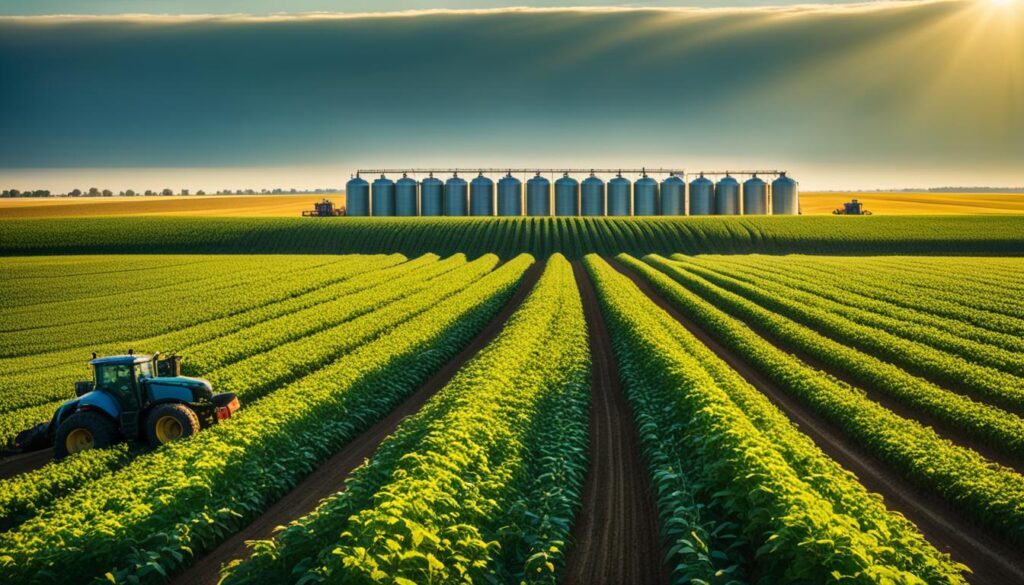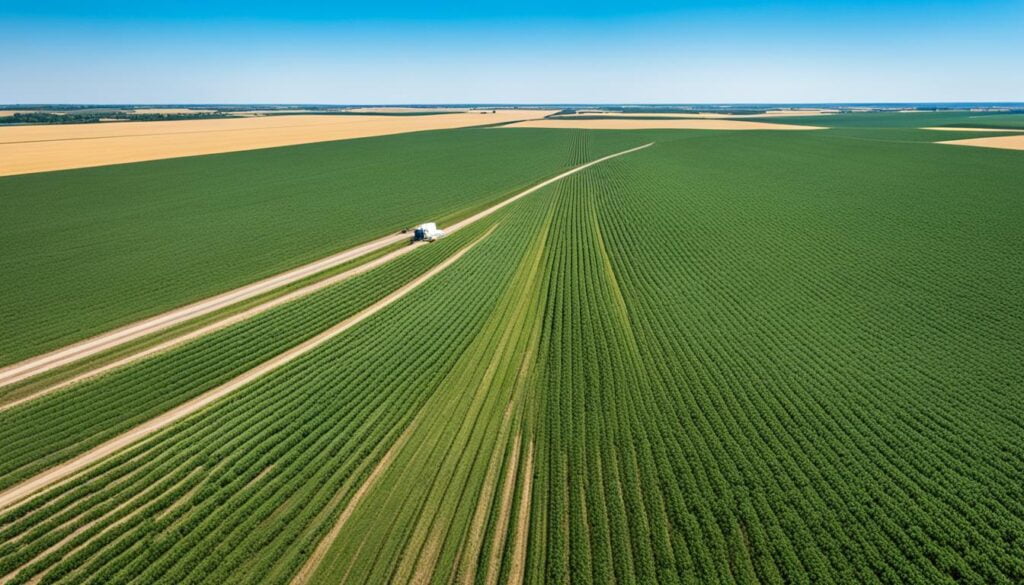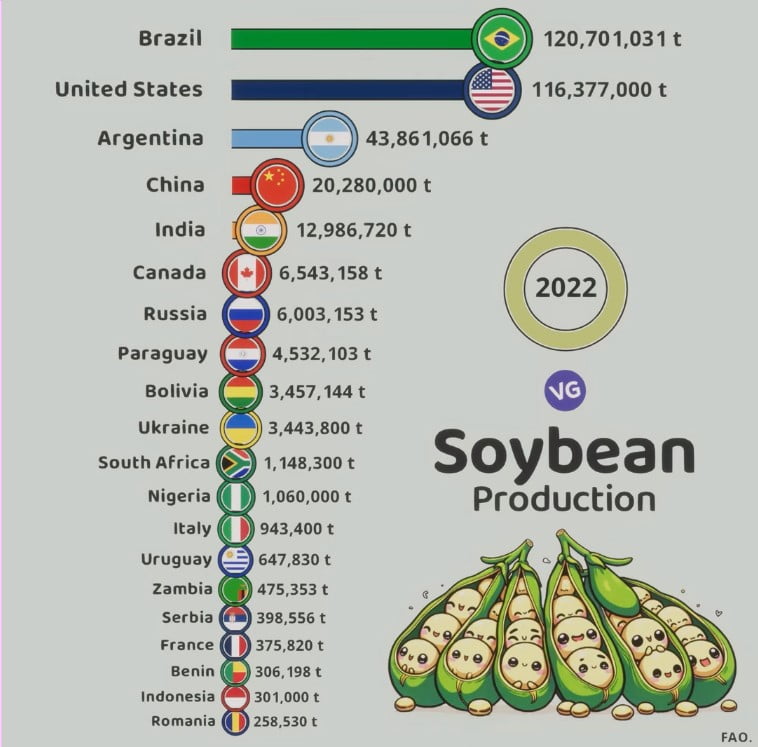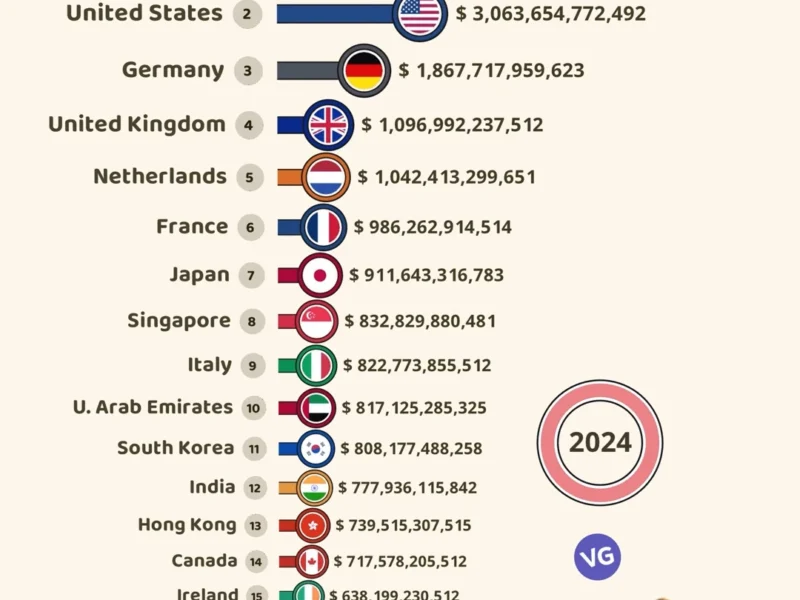The soybean industry is huge, producing over 348 million metric tonnes in 20221. But which countries are leading in growing this versatile crop? You might be surprised by the answer.
The Largest Soybean Producers in the World 2022
| Country | Flag | Production (tons) |
|---|---|---|
| Brazil | 🇧🇷 | 120,701,031 |
| United States | 🇺🇸 | 116,377,000 |
| Argentina | 🇦🇷 | 43,861,066 |
| China | 🇨🇳 | 20,280,000 |
| India | 🇮🇳 | 12,986,720 |
| Canada | 🇨🇦 | 6,543,158 |
| Russia | 🇷🇺 | 6,003,153 |
| Paraguay | 🇵🇾 | 4,532,103 |
| Bolivia | 🇧🇴 | 3,457,144 |
| Ukraine | 🇺🇦 | 3,443,800 |
| South Africa | 🇿🇦 | 1,148,300 |
| Nigeria | 🇳🇬 | 1,060,000 |
| Italy | 🇮🇹 | 943,400 |
| Uruguay | 🇺🇾 | 647,830 |
| Zambia | 🇿🇲 | 475,353 |
| Serbia | 🇷🇸 | 398,556 |
| France | 🇫🇷 | 375,820 |
| Benin | 🇧🇯 | 306,198 |
| Indonesia | 🇮🇩 | 301,000 |
| Romania | 🇷🇴 | 258,530 |
Brazil leads the world, making up 35% of global production in 2022 with 120,701,031 metric tonnes1. The United States is second, producing 116,377,000 metric tonnes1. Argentina is third, with 43,861,066 metric tonnes1.
Together, these three countries, along with China and India, make up over 90% of the world’s soybean production2. As demand for soybeans grows, competition among these countries will get fiercer.
Soybean Production by Country (2022)
Source: FAO (as shown in the image)
.
Key Takeaways
- Brazil is the world’s largest soybean producer, accounting for 35% of global production in 2022.
- The United States is the second-largest soybean producer, followed by Argentina as the third-largest.
- The top five soybean-producing countries (Brazil, USA, Argentina, China, and India) collectively account for over 90% of global soybean output.
- Global soybean production reached over 348 million metric tonnes in 2022, with a projected further increase in the coming years.
- Soybean production is a lucrative and strategically important industry, with major players vying for dominance in the global market.
Global Soybean Production Statistics
The global soybean production has seen ups and downs in recent years. In 2022, the total production fell by 6.4% to 348,856,427 metric tonnes from the year before1. Brazil led as the top producer, making up 35% of the world’s soybeans. The United States was close behind, producing 33%1. Argentina, China, and India also made significant contributions, each producing over a billion soybeans1.
Current and Projected Global Output
Looking forward, soybean production is set to rise from 378.37 million metric tons in 2022/2023 to 395.91 million metric tons in 2023/20242. This represents a 5% increase. The top 10 countries, including Brazil, the USA, and Argentina, will produce over 80% of the world’s soybeans in 20242.
Top Soybean Producing Countries
Brazil and the United States together make up over 65% of global soybean production in 20242. Brazil led with 120.7 million metric tons in 2022–2023, the most globally2. The United States was second, producing 116.4 million metric tons in 20222. Argentina, China, and India completed the top five, each producing millions of metric tons in 2022 and 20232.
The Biggest Soybean Producers in the World
The world’s biggest soybean producers are a group of countries leading the global market. They include Brazil, the United States, Argentina, China, and India3. Together, they produce over 90% of the world’s soybeans, making them key players in agriculture.
Brazil and the United States lead as the top soybean producers. Brazil harvests 86.8 million metric tons, making up 30% of global production3. The United States produces 108.0 million metric tons, accounting for 34% of the world’s soybeans3.
Argentina is the third-biggest producer, adding 18% to the global supply with 53.4 million metric tons3. China and India complete the top five, producing 10.5 million metric tons and 10.0 million metric tons, respectively3.
| Country | Soybean Production (million metric tons) | Global Market Share (%) |
|---|---|---|
| United States | 108.0 | 34% |
| Brazil | 86.8 | 30% |
| Argentina | 53.4 | 18% |
| China | 10.5 | – |
| India | 10.0 | – |
Major players like Paraguay, Canada, Ukraine, Bolivia, and Uruguay also play a role in the soybean market3. As demand for soybeans grows, these leading producers will become even more important.
Brazil, the United States, and Argentina are also major soybean exporters4. China, the biggest soybean consumer and importer, depends on them for its supply. This shows how crucial these countries are to the global food system.
Brazil’s Dominance in Soybean Cultivation
Brazil leads the world in soybean production, making up 35% of global output in 20225. Its ideal climate and vast land make it perfect for growing soybeans5. Brazil also uses advanced farming tech, like precision farming and genetically modified seeds, to boost its soybean production5.
Geographical Advantages
Soybean farming in Brazil has grown from the South to the Midwest and even further north over the years6. The Cerrado biome is key, offering over 165 million hectares for farming6. This area is a major producer of soybeans, maize, cotton, and meat, helping Brazil’s agriculture grow6.
Technological Advancements
Brazil’s soybean industry has seen big tech improvements. Over 20 years, Brazil’s agriculture grew by 8% a year on average,7 with big increases in output and livestock7. This growth is thanks to precision farming, genetically modified seeds, and other new tech5.
More people wanting meat and rising incomes in places like China have pushed up soybean production in Brazil5. Now, Brazil exports more soybeans than the U.S., and it supplies over half the world’s soybean trade from just 17% of its land7.
But, Brazil’s soybean success comes with challenges. In 2016, 82% of soybean producers in Brazil struggled to pay off loans from the 2015/2016 agricultural year,5 showing a long-term debt issue in the sector5. Yet, Brazil’s soybean industry keeps growing thanks to its geography and tech.
United States: A Powerhouse in Soybean Production
The United States leads the world in soybean production, making up 33% of global output in 20228. This top spot comes from large, mechanized farms, cutting-edge farming methods, and a strong network for storing, moving, and exporting soybeans8.
The soybean industry is a big deal for the US economy, bringing in $124 billion in 20229. Over the last 40 years, soybean yields have gone up a lot. Now, farmers get about 51 bushels per acre, up from 31 in 19809.
Exports are key to the US soybean market’s success. In 2021, the country made $26.4 billion from soybean exports, a big jump from the early 2000s9. China, the biggest soybean user, buys about half of the US’s soybean exports by value9.
But the US soybean industry is facing stiff competition, especially from Brazil, now the top soybean producer and exporter9. To stay ahead, the US is looking into new uses for soybeans, like biofuels and bioplastics9.
| Metric | 2020/21 Season | 2030 Projection | Percent Change |
|---|---|---|---|
| US Soybean Production (million bushels) | 4,135 | 4,905 | 18.6% |
| US Soybean Planted Area (million acres) | 83 | 90 | 8.3% |
“The United States has established itself as a global powerhouse in soybean production, leveraging its advanced agricultural practices and extensive infrastructure to maintain its position as a major player in the international soybean market.”
The US’s big farms, new farming methods, and strong export network have made it a leader in soybean production89.
Argentina’s Role in the Global Soybean Market
Argentina is the world’s third-largest soybean producer, playing a big part in the global soybean trade10. It’s expected to produce 49.7 million tonnes of soybeans in 2023-2024, a 99% increase from last year10. Argentina will also increase its soy meal exports to 34.8% of the world’s total in 2023-202410.
Challenges and Opportunities
Argentina’s soybean industry faces challenges like changing exchange rates, policy shifts, and weather risks10. In 2022-2023, soybean crush levels dropped to 27 million tonnes, a 30% decrease from before10. Yet, there are chances to grow soybean production, like using more land and new tech to boost yields.
Argentina is a big name in the global biotech crop market, ranking third in 2019 with 59 million acres of biotech crops11. Its agri-entrepreneurs are using artificial intelligence to spray only on weeds, not whole soybean fields. This can cut down on environmental harm11.
But, growing soybeans in Argentina has environmental and social concerns11. It’s linked to more deforestation, mainly in the Chaco forest, and causes conflicts with local communities11.
Despite these issues, Argentina is still a key player in the soybean market, helping supply this important crop12. Its success depends on balancing economic growth with protecting the environment11.
Emerging Soybean Producers
Brazil, the United States, and Argentina lead the soybean market. But, countries like China and India are becoming big players too. They bring new chances and challenges to the soybean world.
China’s Growing Demand
China is the biggest soybean buyer in the world. It’s boosting its soybean production to meet growing needs13. Over the last 20 years, Brazil has increased its soybean production a lot. The U.S. has seen a 130% increase too13.
This change means we need a new contract to track soybean prices between the U.S. and Brazil13. Now, Brazil supplies 73% of China’s soybean imports in 2023, up from 40% the year before14.
India’s Potential
India has a lot of land and a growing population, making it a big potential soybean producer13. Its soybean production is rising, but it’s still behind the leaders. With the world needing more soybeans, India could become a key player.

China and India are changing the soybean market. While Brazil, the U.S., and Argentina are still leaders, these new players are important too. Keeping an eye on how soybean production and trade change will be key for everyone involved.
Soybean Production per Capita
Looking at soybean production per person changes the ranking of top countries a lot. The United States leads in soybean production but isn’t at the top for per capita production15. Paraguay, Argentina, Brazil, Uruguay, and the United States are the leaders in soybean yields per person15.
These countries have high soybean production per capita due to efficient farming, good weather, and a lot of land for soybeans15. This leads to high soybean yields. They produce more soybeans per person than the world’s biggest soybean producers15.
Top Countries by Soybean Yield per Person
- Paraguay
- Argentina
- Brazil
- Uruguay
- United States
“The top soybean producing countries per capita are Paraguay, Argentina, Brazil, Uruguay, and the United States. These countries benefit from efficient farming practices, favorable climates, and large land areas devoted to soybean cultivation, leading to high soybean yields per person.”
These countries focus on making soybean production more efficient. They produce more soybeans per person than others worldwide. This makes them the top soybean producers per person15.
Environmental and Sustainability Considerations
The growth of soybean production has led to concerns about its environmental effects. These include deforestation, habitat loss, and increased greenhouse gas emissions16. To address these issues, there’s a push for sustainable farming methods in the soybean industry17.
Deforestation is a big worry due to soybean farming16. The Amazon rainforest has lost about 17% of its land to deforestation. This has resulted in 30% less carbon storage than in the 1990s16. To fight this, groups like the Roundtable on Responsible Soy and ProTerra promote sustainable farming and track the soybean supply chain16.
Using sustainable farming methods like precision agriculture and crop rotation helps reduce soybean production’s environmental harm17. These methods cut down on water use, emissions, and help protect nature17. Choosing soy over meat is also better for the planet, as it produces less greenhouse gases than livestock farming17.
But the environmental effects of soybeans don’t stop at farming17. Processing soy into products like vegan burgers or tofu also uses a lot of energy. This can cancel out the benefits of choosing soy over meat17. So, eating a varied plant-based diet with foods like nut butters and nutritional yeast is key for a sustainable lifestyle17.

The soybean industry must focus on sustainability as it faces environmental challenges in food production16. By choosing sustainable farming and making smart choices, we can lessen the environmental impact of soybeans. This way, we can work towards a greener future17.
Conclusion
Brazil, the United States, and Argentina lead the soybean industry, producing over 80% of the world’s soybeans18. Countries like China and India are also boosting their soybean production to meet growing demand18. It’s important to focus on environmental and sustainability issues for the soybean industry’s future.
In the last 50 years, soybean production has grown a lot, reaching over 100 million metric tons a year18. The United States, Brazil, and China are top producers, making up 45%, 20%, and 12% of global soybeans, respectively18. The U.S. is the biggest soybean exporter, and Japan imports the most18. Also, over 25% of soybeans are traded worldwide18.
The soybean industry has both challenges and chances ahead. It needs to work on sustainable farming and reduce deforestation to stay viable18. The demand for plant-based proteins is also a chance for soybean producers, as soybeans could supply a lot of the world’s protein18. By tackling these issues, the soybean industry can keep playing a key role in food security and economic growth.
FAQ
What is the global production of soybeans projected to be in 2023/2024?
The global soybean production is expected to hit 395.91 million metric tons in 2023/2024. This is a 5% increase from the previous year.
What is the compound average growth rate of global soybean production over the past 10 years?
Over the last 10 years, soybean production has grown by about 2% each year on average.
Which are the top soybean producing countries in the world?
The top soybean producers are Brazil, the United States, Argentina, China, and India. Together, they produce over 90% of the world’s soybeans.
What is the current global soybean production and how is it expected to change in the next year?
Soybean production is set to increase from 378.37 million metric tons in 2022/2023 to 395.91 million metric tons in 2023/2024. This represents a 5% growth.
Which countries are the largest soybean producers in the world?
The biggest soybean producers are Brazil, the United States, Argentina, China, and India. These countries make up over 90% of global soybean production.
What factors contribute to Brazil’s position as the world’s largest soybean producer?
Brazil leads in soybean production thanks to its ideal climate and vast land. It also invests in advanced farming tech, like precision farming and genetically modified seeds, which boosts yields.
What are the advantages that have allowed the United States to maintain its status as a major player in the global soybean market?
The US soybean industry thrives on large, mechanized farms and advanced farming methods. It also has strong infrastructure for storing, transporting, and exporting soybeans.
What are the challenges and opportunities facing Argentina’s soybean industry?
Argentina’s soybean industry faces issues like currency fluctuations and policy changes. Yet, it has chances to grow by using more land and new farming tech to increase yields.
Which countries are emerging as significant soybean producers?
Countries like China and India are upping their soybean production to meet growing demand. This is changing the global soybean market.
Which countries have the highest soybean production per capita?
Countries like Paraguay, Argentina, Brazil, Uruguay, and the United States lead in soybean production per person. They have efficient farming, favorable climates, and lots of land for soybeans.
What are the environmental and sustainability concerns surrounding the soybean industry?
The soybean industry’s growth worries environmentalists about deforestation, habitat loss, and emissions. To address this, there’s a push for sustainable farming. This includes precision agriculture and using cover crops.
Source Links
- List of countries by soybean production – https://en.wikipedia.org/wiki/List_of_countries_by_soybean_production
- List of Top 10 Largest Soybean-Producing Countries in the World – https://www.geeksforgeeks.org/largest-soybean-producing-countries-in-the-world/
- 10 Countries With Largest Soybean Production – https://www.worldatlas.com/articles/world-leaders-in-soya-soybean-production-by-country.html
- World Soybean Trade – https://www.iowafarmbureau.com/Article/World-Soybean-Trade
- Frontiers | The Soybean Trap: Challenges and Risks for Brazilian Producers – https://www.frontiersin.org/journals/sustainable-food-systems/articles/10.3389/fsufs.2020.00012/full
- The rapid soybean growth in Brazil | OCL – https://www.ocl-journal.org/articles/ocl/full_html/2018/01/ocl170039/ocl170039.html
- USDA ERS – Brazil’s Momentum as a Global Agricultural Supplier Faces Headwinds – https://www.ers.usda.gov/amber-waves/2022/september/brazil-s-momentum-as-a-global-agricultural-supplier-faces-headwinds/
- Brazil Likely to Remain World Leader in Soybean Production – farmdoc daily – https://farmdocdaily.illinois.edu/2021/07/brazil-likely-to-remain-world-leader-in-soybean-production.html
- How U.S. soybeans influence global economics – https://www.cnbc.com/2023/10/12/how-us-soybeans-influence-global-economics-.html
- Argentina expected to regain first place in soy meal exports despite fierce competition – Fastmarkets – https://www.fastmarkets.com/insights/argentina-expected-to-regain-first-place-in-soy-meal-exports/
- The Impact of Soybeans in Argentina and Beyond: A Double-Edged Sword? – https://revista.drclas.harvard.edu/the-impact-of-soybeans-in-argentina-and-beyond-a-double-edged-sword/
- No title found – https://www.unav.edu/web/global-affairs/detalle/-/blogs/soybeans-the-other-strategic-commodity-of-south-america
- Paid Program: Two Reasons Why Brazil Has Emerged as a Global Leader in Soybean Production – https://partners.barrons.com/cme-group/two-reasons-why-brazil-has-emerged-as-a-global-leader-in-soybean-production/
- The United States, Brazil, and China Soybean Triangle: A 20-Year Analysis – farmdoc daily – https://farmdocdaily.illinois.edu/2024/02/the-united-states-brazil-and-china-soybean-triangle-a-20-year-analysis.html
- USDA ERS – Soybeans and Oil Crops – https://www.ers.usda.gov/topics/crops/soybeans-and-oil-crops/
- Is Soya Sustainable? | Ethical Consumer – https://www.ethicalconsumer.org/food-drink/soya-sustainable
- The Environmental Impact of Soybean Products Explained – https://greenly.earth/en-us/blog/ecology-news/the-environmental-impact-of-soybean-products-explained
- Technology of production of edible flours and protein products from soybeans. Chapter 1. – https://www.fao.org/4/t0532e/t0532e02.htm



